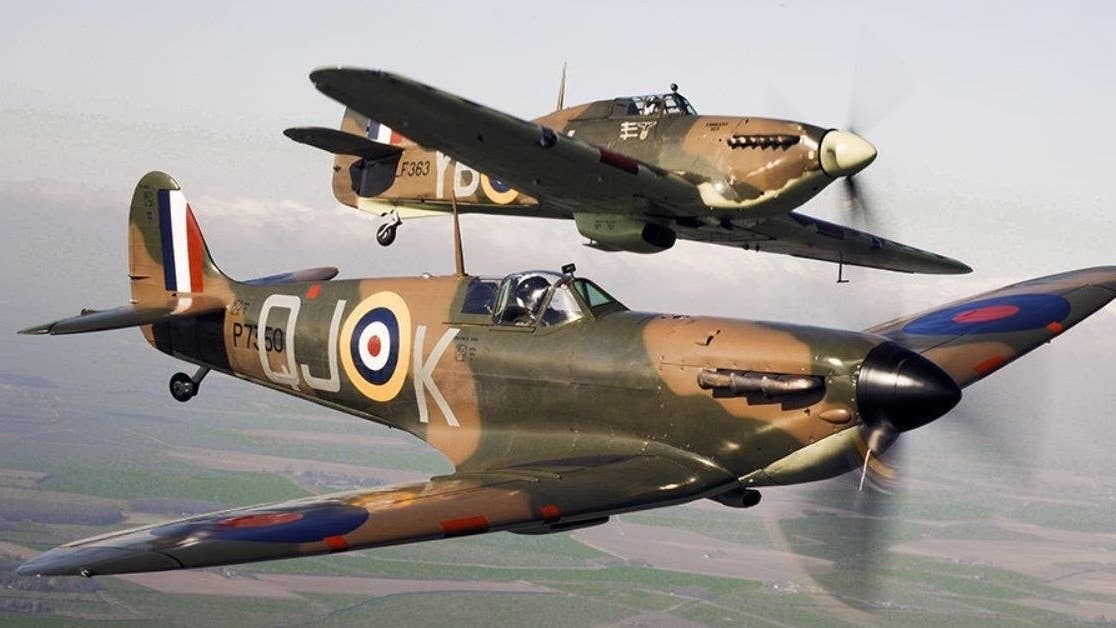The Hurricane is the overlooked hero of the Battle of Britain

A Spitfire and Hurricane fly together during a Battle of Britain commemorative flight (Ministry of Defence photo)
SUMMARY
The Battle of Britain was a turning point for the allied forces during WWII. After their evacuation at Dunkirk, the British Army was in a poor state, having abandoned much of its warfighting equipment and machinery in France. The Home Guard, the armed citizen militia that supported the British Army, was mobilized in anticipation of a German invasion of the British Isles. As Prime Minister Winston Churchill said, the British people prepared to fight the Germans on the beaches, on the landing grounds, in the fields and in the streets, and in the hills. Ferrying an army across the English Channel is no easy task though, and the Germans needed to secure air superiority before their invasion.
In July 1940, Germany began an air and sea blockade of Britain with the goal of compelling her government to negotiate a peace settlement. Initially targeting coastal-shipping convoys, ports, and shipping centers, the German Luftwaffe was redirected to incapacitate RAF Fighter Command on August 1. They targeted airfields and infrastructure in an attempt to defeat the RAF on the ground. It was the job of the RAF's fighter pilots to repel these attacks by the much larger German Luftwaffe. In the words of Air Chief Marshal Hugh Dowding, "Our young men will have to shoot down their young men at the rate of five to one."
When people think about the Battle of Britain, they often envision elegant Supermarine Spitfires with their large, elliptical wings, locked in a deadly aerial ballet with German Messerschmitt Bf 109s. Or perhaps a mental image is conjured of those same beautiful Spitfires cutting swathes through formations of Luftwaffe Ju 87 Stuka dive-bombers or Heinkel He 111 level bombers. Either way, the hero aircraft of the Battle of Britain that most people remember is the Supermarine Spitfire. However, the truth of the matter is that the Hawker Hurricane shot down more German aircraft than all other air and ground defenses combined during the Battle of Britain.
Although it was not nearly as pretty as the Spitfire, looking rather like a sad Basset Hound, the Hurricane was a more stable gun platform with its thicker wings. They allowed its eight .303 Browning machine guns to be mounted closer together in the wings and closer to the center of the aircraft, producing more accurate fire. Though the Spitfire was armed with the exact same guns, its thinner wings forced them to be mounted further out from the fuselage which caused the plane to become unbalanced when they were fired.
The Hurricane, with its wood and fabric construction, was also easier for ground crews to repair and conduct maintenance on. Conversely, the Spitfire's metal construction meant that skilled metal workers were needed to conduct repairs. This difference in design also meant that the Hurricane could be produced quicker and in larger numbers than the Spitfire. During the Battle of Britain, 32 RAF fighter squadrons flew the Hurricane whereas only 19 squadrons flew Spitfires.
This is not to say that the Spitfire was inferior to the Hurricane; in fact, it was arguably the better dogfighter. Although both planes were powered by the same Rolls-Royce 27-litre liquid-cooled V-12 Merlin engine, the Spitfire could climb faster and turn tighter thanks to its wing design. As a result, Spitfires were generally directed to intercept the Luftwaffe escort fighters while Hurricanes attacked the enemy bomber formations.
In short, neither the Spitfire nor the Hurricane could have won the Battle of Britain alone. The two planes complemented each other in the sky and worked together to repel the onslaught of German air attacks. In the end, the RAF reported 1,542 aircrew killed and 1,744 aircraft destroyed while the Luftwaffe reported 2,585 aircrew killed or missing, 925 captured, and 1,634 aircraft destroyed in combat. Failing to establish air superiority over Britain, Hitler was forced to postpone his invasion indefinitely. Shooting down a majority portion of enemy aircraft, the Hurricane deserves its fair share of fame alongside the Spitfire in staving off the Nazi threat.
SHARE
